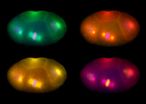(Press-News.org) Researchers are always searching for improved technologies, but the most efficient computer possible already exists. It can learn and adapt without needing to be programmed or updated. It has nearly limitless memory, is difficult to crash, and works at extremely fast speeds. It's not a Mac or a PC; it's the human brain. And scientists around the world want to mimic its abilities.
Both academic and industrial laboratories are working to develop computers that operate more like the human brain. Instead of operating like a conventional, digital system, these new devices could potentially function more like a network of neurons.
"Computers are very impressive in many ways, but they're not equal to the mind," said Mark Hersam, the Bette and Neison Harris Chair in Teaching Excellence in Northwestern University's McCormick School of Engineering. "Neurons can achieve very complicated computation with very low power consumption compared to a digital computer."
A team of Northwestern researchers, including Hersam, has accomplished a new step forward in electronics that could bring brain-like computing closer to reality. The team's work advances memory resistors, or "memristors," which are resistors in a circuit that "remember" how much current has flowed through them.
The research is described in the April 6 issue of Nature Nanotechnology. Tobin Marks, the Vladimir N. Ipatieff Professor of Catalytic Chemistry, and Lincoln Lauhon, professor of materials science and engineering, are also authors on the paper. Vinod Sangwan, a postdoctoral fellow co-advised by Hersam, Marks, and Lauhon, served as first author. The remaining co-authors--Deep Jariwala, In Soo Kim, and Kan-Sheng Chen--are members of the Hersam, Marks, and/or Lauhon research groups.
"Memristors could be used as a memory element in an integrated circuit or computer," Hersam said. "Unlike other memories that exist today in modern electronics, memristors are stable and remember their state even if you lose power."
Current computers use random access memory (RAM), which moves very quickly as a user works but does not retain unsaved data if power is lost. Flash drives, on the other hand, store information when they are not powered but work much slower. Memristors could provide a memory that is the best of both worlds: fast and reliable. But there's a problem: memristors are two-terminal electronic devices, which can only control one voltage channel. Hersam wanted to transform it into a three-terminal device, allowing it to be used in more complex electronic circuits and systems.
Hersam and his team met this challenge by using single-layer molybdenum disulfide (MoS2), an atomically thin, two-dimensional nanomaterial semiconductor. Much like the way fibers are arranged in wood, atoms are arranged in a certain direction--called "grains"--within a material. The sheet of MoS2 that Hersam used has a well-defined grain boundary, which is the interface where two different grains come together.
"Because the atoms are not in the same orientation, there are unsatisfied chemical bonds at that interface," Hersam explained. "These grain boundaries influence the flow of current, so they can serve as a means of tuning resistance."
When a large electric field is applied, the grain boundary literally moves, causing a change in resistance. By using MoS2 with this grain boundary defect instead of the typical metal-oxide-metal memristor structure, the team presented a novel three-terminal memristive device that is widely tunable with a gate electrode.
"With a memristor that can be tuned with a third electrode, we have the possibility to realize a function you could not previously achieve," Hersam said. "A three-terminal memristor has been proposed as a means of realizing brain-like computing. We are now actively exploring this possibility in the laboratory."
INFORMATION:
New mothers in the Philippines spend more time in the bedroom with their partner in the first few weeks after giving birth than they did before they became pregnant. This might be a type of survival strategy to keep the relationships with the fathers of their new babies alive and well, to ensure continued support for their offspring. So says Michelle Escasa-Dorne of the University of Colorado in the US, after studying how women from a society with a low divorce rate such as the Philippines adapt to being both mothers and lovers. The study appears in Springer's journal Human ...
WINSTON-SALEM, N.C. - April 6, 2015 - A commonly prescribed antidepressant caused up to a six-fold increase in atherosclerosis plaque in the coronary arteries of non-human primates, according to a study by researchers at Wake Forest Baptist Medical Center. Coronary artery atherosclerosis is the primary cause of heart attacks.
The study is published in the current online issue of the journal Psychosomatic Medicine.
"The medical community has known for years that depression is closely associated with heart disease, but we didn't know if treating it would reduce the heart ...
A new UCLA study takes another step toward the early understanding of a degenerative brain condition called chronic traumatic encephalopathy, or CTE, which affects athletes in contact sports who are exposed to repetitive brain injuries. Using a new imaging tool, researchers found a strikingly similar pattern of abnormal protein deposits in the brains of retired NFL players who suffered from concussions.
The innovative imaging technique uses a chemical marker combined with positron emission tomography, or PET scan, and was initially tested in five retired NFL players ...
SAN FRANCISCO--The Pacific and North America plate boundary off the coast of British Columbia and southeastern Alaska is a complex system of faults capable of producing very large earthquakes. The recent 2012 Mw 7.8 Haida Gwaii and 2013 Mw 7.5 Craig earthquakes released strain built up over years, but did not release strain along the Queen Charlotte Fault, which remains the likely source of a future large earthquake, according to reports published in a special issue of the Bulletin of the Seismological Society of America (BSSA).
"The study of these two quakes revealed ...
Massachusetts General Hospital (MGH) investigators have identified an inflammatory molecule that appears to play an essential role in the autoimmune disorder systemic lupus erythematosus, commonly known as lupus. In their report being published online in Nature Immunology, the researchers describe finding that a protein that regulates certain cells in the innate immune system - the body's first line of defense against infection - activates a molecular pathway known to be associated with lupus and that the protein's activity is required for the development of lupus symptoms ...
MIT researchers have developed a new, ultrasensitive magnetic-field detector that is 1,000 times more energy-efficient than its predecessors. It could lead to miniaturized, battery-powered devices for medical and materials imaging, contraband detection, and even geological exploration.
Magnetic-field detectors, or magnetometers, are already used for all those applications. But existing technologies have drawbacks: Some rely on gas-filled chambers; others work only in narrow frequency bands, limiting their utility.
Synthetic diamonds with nitrogen vacancies (NVs) -- ...
Dividing cells--whether they're in an embryo or an adult--rely on the right processes happening at the right time to turn out healthy.
Now, researchers at the University of Iowa have identified a mechanism that dividing cells in worms use to ensure their proper development, and they believe the same process could be going on in humans. The mechanism, unknown until now, describes one part of the cell, called the centrosome, as an "internal timekeeper"--like a train conductor. A crucial protein in charge of gene expression, beta-catenin, is described as a "hitchhiker"--it ...
Physical activity that makes you puff and sweat is key to avoiding an early death, a large Australian study of middle-aged and older adults has found.
The researchers followed 204,542 people for more than six years, and compared those who engaged in only moderate activity (such as gentle swimming, social tennis, or household chores) with those who included at least some vigorous activity (such as jogging, aerobics or competitive tennis).
They found that the risk of mortality for those who included some vigorous activity was 9 to 13 per cent lower, compared with those ...
Leading coral reef scientists say Australia could restore the Great Barrier Reef to its former glory through better policies that focus on science, protection and conservation.
In a paper published in the journal Nature Climate Change, the authors argue that all the stressors on the Reef need to be reduced for it to recover.
An Australian Government report into the state of the Great Barrier Reef found that its condition in 2014 was "poor and expected to further deteriorate in the future". In the past 40 years, the Reef has lost more than half of its coral cover and ...
Many nursing home residents who underwent lower extremity revascularization died, did not walk or had functional decline following the procedure, which is commonly used to treat leg pain caused by peripheral arterial disease, wounds that will not heal or worsening gangrene, according to an article published online by JAMA Internal Medicine.
Lower extremity revascularization is often performed so patients with peripheral arterial disease can maintain the ability to walk, which is a key component of functional independence. But outcomes among patients with high levels of ...


